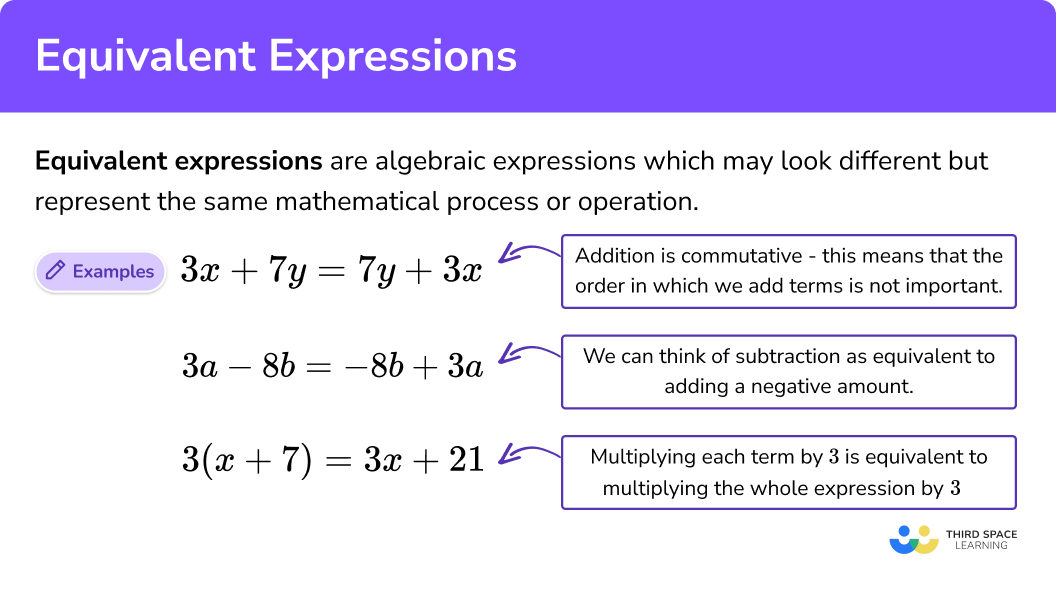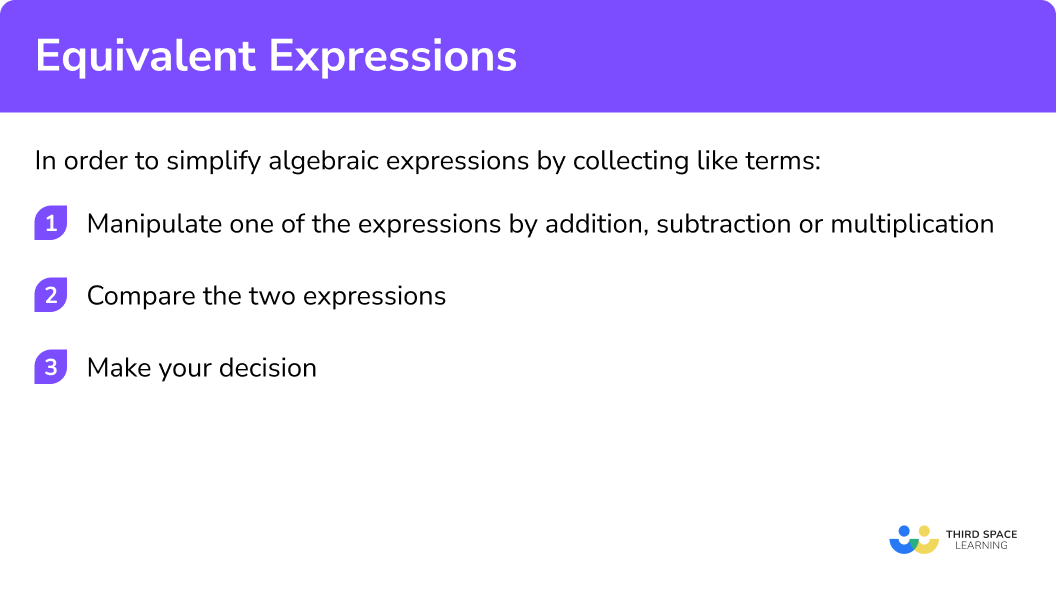GCSE Tutoring Programme
Our chosen students improved 1.19 of a grade on average - 0.45 more than those who didn't have the tutoring.
In order to access this I need to be confident with:
Arithmetic Laws of indices Squares and square roots BIDMAS (order of operations)Algebraic terms
Simplify expressions Collecting like terms Expanding bracketsThis topic is relevant for:

Equivalent Expressions
Here we will learn about equivalent expressions, including what they are and how to recognise them.
There are also equivalent expressions worksheets with practice problems based on Edexcel, AQA and OCR exam questions, along with further guidance on where to go next if you’re still stuck.
What are equivalent expressions?
Equivalent expressions are algebraic expressions which may look different but represent the same mathematical process or operation.
An algebraic expression is two or more numbers and letters that are combined with mathematical operations such as \; +, \; -, \; \times \; or \; \div .
Two expressions are equivalent if they have the same value for any possible substituted value(s) of the variable(s) involved. We use the symbol \; \equiv \; to show that two expressions are equivalent.
For example, the equation 3x+2=14 is only true for one value of x, i.e. x=3.
But the statement 3x+2=2+3x is true for all possible values of x that we could substitute in, so we write 3x+2\equiv2+3x
Let’s look at some more examples of equivalent expressions.
What are equivalent expressions?

- Addition
Addition is commutative which means the order in which we add the terms is not important – the answer will be the same.
For example, 3x+7y\equiv7y+3x.
3x+7y is the same as 7y+3x because the values of the variables match. By this we mean that the coefficients of x are the same, the coefficients of y are the same and they are added together. This means they are equivalent expressions.
For example, 3a-8b=3a+(-8b)\equiv-8b+3a.
The negative sign belongs to the term coming straight after it. It may be helpful to think of subtraction as adding a negative number.
3a-8b is the same as 3a+(-8b) which is the same as -8b+3a because when we remove the brackets (parentheses) we are a left with + \; - which is the same as -. This means they are equivalent expressions.
- Multiplication
Multiplication has a distributive property which allows us to break up more complicated multiplication calculations into two simpler parts.
For example, to calculate 3 \times 24 we can split the 24 into 20+4. We can then work out 3 \times 20 and 3 \times 4 and add them together.
So 3 \times 24=3 \times (20+4)=3 \times 20+3 \times 4=60+12=72.
This is used in algebra when we expand brackets.
For example, 3(x+7)\equiv3x+21.
3(x+7) is the same as 3x+21 because 3 \times x=3x and when we multiply the constants 3 and 7 we get 21. The right side is the same as the left side so they are equivalent expressions.
How to use equivalent expressions
In order to use equivalent expressions:
- Manipulate one of the expressions by addition, subtraction or multiplication.
- Compare the two expressions.
- Make your decision.
Explain how to use equivalent expressions


Algebraic expressions worksheet (includes equivalent expressions)

Get your free equivalent expressions worksheet of 20+ algebraic expressions questions and answers. Includes reasoning and applied questions.
DOWNLOAD FREE
Algebraic expressions worksheet (includes equivalent expressions)

Get your free equivalent expressions worksheet of 20+ algebraic expressions questions and answers. Includes reasoning and applied questions.
DOWNLOAD FREEEquivalent expressions examples
Example 1: addition and subtraction
Are the expressions 4a+7b and 7b-4a equivalent?
- Manipulate one of the expressions by addition, subtraction or multiplication.
We can take the first expression and change the order of terms being added, 4a+7b becomes 7b+4a.
2Compare the two expressions.
The two expressions both have ‘4a’ and ‘7b’, but in the second expression the ‘4a’ is negative. It is ‘-4a’
3Make your decision.
The two expressions are not the same. They are NOT equivalent expressions.
Example 2: addition and subtraction
Are the expressions 3c-8d and 8d-3c equivalent?
Manipulate one of the expressions by addition or subtraction or multiplication.
We can take the first expression and change the order of terms being added, 3c-8d becomes -8d+3c.
Compare the two expressions.
The two expressions both have ‘3c’ and ‘8d’, but the ‘3c’ is negative in the second expression but not in the first.
Similarly the ‘8d’ is negative in the first expression, but not in the second.
Make your decision.
The two expressions are not the same. They are NOT equivalent expressions.
Example 3: addition and subtraction
Are the expressions 6 p q^{2}+3 p and 3 p+6 p q^{2} equivalent?
Manipulate one of the expressions by addition or subtraction or multiplication.
We can take the first expression and change the order of terms being added, 6 p q^{2}+3 p becomes 3 p+6 p q^{2}.
Compare the two expressions.
The expressions both have ‘6pq^{2}’ and ‘3p’. It is important to double-check that, when comparing expressions which are polynomials (have powers of 2 or higher), the exponents (powers) are with the same letter in both expressions. All the terms are positive.
Make your decision.
The two expressions are the same. They are equivalent expressions.
Example 4: expanding brackets and factorising
Are the expressions 4(x-5) and 4x-20 equivalent?
Manipulate one of the expressions by addition or subtraction or multiplication.
We can take the first expression and expand the brackets.
4(x-5)=4\times x-4\times 5= 4x-20
Compare the two expressions.
The two expressions are both the same, 4(x-5)\equiv4 x-20.
Make your decision.
The two expressions are the same. They are equivalent expressions.
Example 5: expanding brackets and factorising
Are the expressions p(3p+2) and 3p^{2}-2p equivalent?
Manipulate one of the expressions by addition or subtraction or multiplication.
We can take the first expression and expand the brackets.
p(3p+2) =p\times 3p+p\times 2=3p^2+2p.
Compare the two expressions.
The two expressions have the same terms, ‘3p^{2}’ and ‘2p’, but they have a different mathematical symbol between them.
Make your decision.
The two expressions are not the same. They are NOT equivalent expressions.
Example 6: expanding brackets and factorising
Are the following expressions equivalent?
-(y-5) and 5-y.
Manipulate one of the expressions by addition or subtraction or multiplication.
We can take the first expression and expand the brackets.
-(y-5)=-1(y-5)=-1\times y+-1\times -5= -y+5
Compare the two expressions.
The two expressions are both the same, -y+5\equiv5-y.
Make your decision.
The two expressions are the same. They are equivalent expressions.
Common misconceptions
- The order of subtraction is important
Remember that the order of a subtraction sum is very important.
7-4
\hspace{.23cm} + \; 3
- Confusing multiplying by \bf{2} and squaring
Remember that x+x is written as 2x. This means 2 \times x, or 2 lots of x.
Remember that x multiplied by itself is x \times x which is written as x^{2}.
2x and x^{2} are two different types of algebraic terms.
- Algebraic terms with \bf{2} or more letters
Remember that algebraic terms involving 2 or more letters tend to be written with the letters in alphabetical order. a \times c \times b tends to be written as abc rather than acb.
Practice equivalent expressions questions
1. Which is the equivalent expression to 4+5x ?




The original expression can be changed so that the order in which the two terms are added is reversed.
4+5x\equiv5x+4
2. Which is the equivalent expression to 3a-4b ?




The original expression can be changed so that the order in which the two terms are added is reversed.
3a-4b=3+(-4b)\equiv-4b+3a
3. Which is the equivalent expression to 5x^2+6y^3 ?




The original expression can be changed so that the order in which the two terms are added is reversed.
5x^2+6y^3\equiv6y^3+5x^2
4. Which is the equivalent expression to 3(a+4) ?




The original expression can be expanded.
3(a+4)=3 \times a+3 \times 4\equiv3a+12
5. Which is the equivalent expression to -(x-8) ?




The original expression can be expanded.
-(x-8)=-1(x-8)=-1\times x + -1\times -8=-x+8\equiv8-x
6. Which is the equivalent expression to a(a+3) ?




The original expression can be expanded.
a(a+3)=a \times a+3 \times a\equiv a^{2}+3a
Equivalent expressions GCSE questions
1. Circle the equivalent expression to 3x^{2}-5y^{3}.
-3x^{2}+5y^{3} \hspace{1cm} -5y^{3}+3x^{2} \hspace{1cm} 3y^{2}-5x^{2} \hspace{1cm} -5y^{2}+3x^{2}
(1 mark)
(1)
2. Circle the equivalent expression to x(2x-5).
x^{3}-5x \hspace{1cm} x^{2}-5x \hspace{1cm} 2x^{2}-5 \hspace{1cm} 2x^{2}-5x
(1 mark)
(1)
3. Match the equivalent expressions.
a+a+b+b+b \hspace{3cm} 2a-ab \\ 2a+4b-a-2b \hspace{3cm} a^{2}-ab \\ (a+b)(a-b) \hspace{3.4cm} 2a+3b \\ a(2-b) \hspace{4.2cm} 4b-2a \\ a(a-b) \hspace{4.2cm} 2a-2b \\ -2a+4b \hspace{4.1cm} a+2b \\ 2(a-b) \hspace{4.2cm} a^{2}-b^{2} \\
(3 marks)
2a+4b-a-2b \hspace{3cm} a+2b
(a+b)(a-b) \hspace{3.4cm} a^{2}-b^{2}
a(2-b) \hspace{4.1cm} 2a-ab
a(a-b) \hspace{4.1cm} a^{2}-ab
-2a+4b \hspace{4cm} 4b-2a
2(a-b) \hspace{4.1cm} 2a-2b
(3)
Learning checklist
You have now learned how to:
-
Recognise equivalent expressions
The next lessons are
Still stuck?
Prepare your KS4 students for maths GCSEs success with Third Space Learning. Weekly online one to one GCSE maths revision lessons delivered by expert maths tutors.

Find out more about our GCSE maths tuition programme.